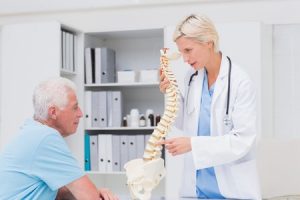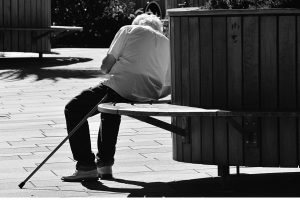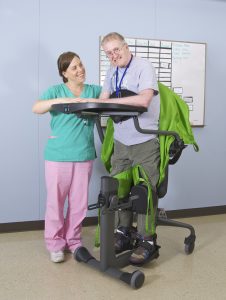What Your Back Pain is Trying to Tell You
Experiencing back, shoulder or neck pain? Your body may be speaking to you and you just don’t know it. Getting older doesn’t have to mean accepting regular aches and pains. Depending on your day to day activity, environment, and mobility, your back pain can be sending loud and clear messages like:
You’re not active enough: This might seem counter intuitive, especially to older adults who are avoiding activity so they don’t “further injure” themselves or cause more pain. The reality is, low-impact exercise and activity helps to alleviate pain and soreness by stretching out your muscles and spine, boosting blood circulation, and reducing inflammation in your muscles, joints, and tendons. Along with keeping off excess weight.
You’re not sleeping well: A bad night’s sleep can undo any number of steps you took towards relieving back pain during the day. Older mattresses that don’t support proper spine alignment while you sleep can result in the pull and strain of your muscles and tendons and lead to bad posture during the day. Optimize on the natural curve of your spine while you sleep by simply using a pillow – on your side in a fetal position, try sleeping with a pillow between your knees. If you sleep on your back, place a pillow underneath your knees.
You’re stressed: Feelings of stress, anxiety or depression can physically translate into tense muscles that lead to back pain and thoughtless behaviors like eating poorly or not exercising, which exacerbate existing conditions. Aging seniors with complex medical conditions or cognitive decline are more likely to experience stress and anxiety as well as feelings of frustration and anger.
You’re not practicing self-care: Incorporating daily care routines into your life can make a huge difference in both your experience of back pain as well as your personal outlook on life. Self-care can be as simple as eating a healthy diet, stretching and exercising to care for your body, meditating, decluttering your environment, and practicing self-soothing techniques like rubbing lotion on your hands and feet before bed. Relieving back pain starts with you and your own self-awareness of what you need and deserve to live your best life.
You’re sitting down too much: Countless aging seniors will spend hours each day sitting down – at meals, watching tv, reading, and at the computer. Sustained inactivity and sitting in one spot for an extended period of time puts significant pressure on the spine and promotes bad posture, all of which lead to back pain and discomfort. Experts recommend not going more than 30 or 45 minutes sitting in one place without getting up to stretch, walk around, and change positions.
Get this!
According to a recent report published by the American College of Physicians*, people who experience moderate to acute back pain are actually more likely to experience relief when they try exercise, yoga, acupuncture or massage instead of taking pain killers. The comprehensive study revealed that most types of back pain go away over time whether they are treated or not and that drugs should be a last resort for alleviating pain, after mindfulness-based practices, exercise, spinal manipulation, even heat wraps.
Joe Fleming
Co-Founder, Vive Health
Guest Blog: What to Look For in a Senior Living Community
Before you look up a senior living community or Google personal care homes near me, you should first get to know about the common options available for where your aging parents can reside.
Below are the most popular and preferred options to pick from –
- Independent Living – This type of living is good for the elderly who can largely function independently with occasional medical care required. Medical care is provided in collaboration with hospitals or medical establishments. Typical services include accommodation, laundry, transportation, housekeeping, and other amenities like pool, concierge service, library, fitness center, etc.
- Assisted Living – Assisted living centers, in addition to accommodation also provide onsite health care and help with ADLs like dressing, bathing, and medication management so residents can live independently. The setting is very home-like without the residents having to worry about maintenance, cooking, or cleaning. There’s round-the-clock supervision available.
- Memory Care – This facility is specifically designed to treat and care for people with dementia or Alzheimer’s. The staff is medically trained to handle their special medical needs. The rooms and buildings are structured to avoid wandering. Supervision is available all the time with plenty of programs for socialization. There are housing and laundry services along with an emergency medical call system.
- Enhanced Living – You can think of this facility as a move up from Independent living with a whole lot of extra services available.
Things To Look For In A Senior Living Community
Senior Living Culture
Now the living culture is not something that you define in words. It’s mostly just a feel or a vibe that you pick up on. At times, you just know it when you visit the facility. Other times it’s a hunch of an intuition.
To truly assess the culture, it’s better if you call up your list of communities and visit them one by one. Observe the residents and see if they seem happy. How is the staff? Are they polite to respond? Is the overall energy of the place happy? Ask for social activities to keep the residents happy.
Lifestyle & Wellness
Lifestyle and wellness largely depend on the social calendar of the place. So, be sure to look at those activities as well as exercise, health, and wellness programs. Make sure to ask about how often the residents are allowed to go out for activities.
What about housekeeping and laundry services? How often are friends and families allowed to visit? Is there a dedicated private or common area for family get-togethers? What about pets? Are they allowed?
Staff and Care
How many staff members are present at the facility? Are the staff members nice to interact with the residents? Do they seem polite? What kind of help can you expect from them? Is the medical staff made to undergo regular training to update their knowledge?
What’s the mode of communication for updating families on the health updates of the residents? Also, how quickly can you expect your questions to be answered? What kind of care is available for residents with special medical issues such as diabetes, memory, or mobility issues?
What’s Food Like?
Food is a huge part of staying healthy during old age. So, this is something you must not overlook. If possible, arrange for a tour of the mess/kitchen. Look into how the food is prepared. Are the conditions there hygienic?
What about the food menu? Does it look interesting? Is it extensive and accommodates special dietary restrictions such as gluten-free and vegan-friendly foods? What are the dining hours like and is there food sampling available?
Extra Amenities
It’s not uncommon for people to get stuck between two close contenders. Sometimes two communities can look exactly the same; making it difficult to pick one. When faced with such a dilemma it’s often the extra amenities that help you make the right choice.
See if the laundry and housekeeping services are free. Some facilities charge extra for those. Look into community events, transportation, or socialization activities. Anything extra is a good thing to consider.
History and Reputation
How long has the community been in business? For how long has the management been with the community? What about the staff? For how many years they have been working there?
One of the best things to discern all this and more is to go online. Check out reviews and see what they have to say. Pay attention to how the community has responded to negative reviews. Only avoid the community if you come across something disturbing like bad handling of residents or complete neglect on part of the staff.
Bottom Line
Selecting the right living community for your senior can seem like a daunting task. But, if you invest a little bit of time and effort, it should be a cakewalk.
Guest Blog: Tips For Preventing Falls Among The Elderly
Falls among seniors are more common than you think.
According to the Centers For Disease Control and Prevention, nearly 36 million older adults suffer a fall each year.
Our muscles lose strength, and our balance and coordination decline as we get older. As our senior loved ones are already at a certain age, they are now more prone to falls, and it could only get worse as they get on in years.
However, we can take steps to keep our seniors from suffering falls. Here are some tips on how to prevent falls among the elderly.
Declutter
Make sure your parent’s or grandparent’s space is clutter-free. You can’t have random stuff lying all over the place, becoming a tripping hazard for seniors. The floors that your elderly loved one walks on should always be clear, with nothing to step, slip, and trip on.
Put Up Grab Bars & Handrails In Strategic Spots
Seniors can use additional support when walking around the house. So, it would be great if the hallways, bathrooms, and stairways are fitted with handrails and grab bars.
Add More Lights
Our seniors typically have poor eyesight, which can only get worse under poor lighting conditions. By installing additional lights (and brighter ones at that), seniors will have a better chance of seeing and avoiding tripping and slipping hazards as they go about the house.
Use Only Non-Slip Mats & Rugs
All the mats and rugs in the house should be the non-slip type or secured to the floor.
Get Them To Exercise Regularly
Regular exercise is crucial to keeping the muscles, bones, and sense of balance of our seniors strong. Walking, lifting light weights, climbing stairs, or doing something as simple as standing on one leg for a minute or two can already help them stay as fit as possible. The fitter they are, the lower their risk of suffering a fall.
Tell Them To Be More Careful
Sometimes, seniors fall because they try to move too fast when walking across the room or getting out of bed. Tell them they need to be more careful when doing so and always move at a more comfortable pace.
Falls don’t have to be synonymous with getting older. By taking the necessary precautions, our seniors stand a better chance of avoiding them.
About the Author
Melissa Andrews is the Content Marketing Strategist for Paradise Living Centers, an assisted living center for seniors with locations in Paradise Valley and Phoenix, Arizona. In her spare time, she enjoys cooking and going on hiking trips with her siblings and cousins.
How Can You Tell if Your Elderly Family Member Needs Home Care
Accepting the need for assistance is not easy for adults as they get older. So, how will you determine when your elderly parent needs home care? One thing is sure: your parents are not likely to be the ones who tell you.
Older adults have a desire to remain independent and be in control. Usually, a senior will hide any issues out of fear of being a burden or because they are embarrassed or ashamed. However, until a sudden decline in their overall health makes it obvious, they need assistance. Since adult children don’t come up with a care decision plan before the crisis takes place, the stress of an unexpected hospitalization complicates things even more.
One way to avoid this problematic scenario is to start regularly monitoring your aging parent’s mental and physical abilities. Make sure he knows this is not an accusation but instead a way to help him maintain his independence for as long as possible. It is not easy to see a loved one’s health decline, but you can help them avoid any medical crisis if you know the signs. To determine whether your parents need home care, keep an eye on the following essential signs:
Essential Signs that Your Elderly Family Member Needs Home Care
1. Difficulty Getting Around
As many experts agree, most people over the age of 70 need some help to go about their routine. However, your family member may not feel comfortable telling you that he needs assistance. Over time, vision and hearing loss may become severe enough to limit your loved one’s ability to move around the house without help. Your parents will also need some help if they begin having problems with balance or coordination.
2. Difficulty Taking Care of Themselves
While it is normal for older adults to deal with medical issues eventually, it is not normal for them to not take care of themselves altogether. It is one of the most obvious signs that your loved one needs help. When you notice that they are unable to take care of their hygiene or clean up after themselves, you have to intervene.
3. Physical Decline
As the years’ progress, most elderly adults will experience a gradual decrease in physical fitness and mobility. However, some older adults experience a sudden decline in health that is too rapid to be recognized by any family member. Once this happens, they can’t regain their full strength and mobility before they are forced to seek home care assistance.
4. Cluttered Home
In most cases, older adults take pride in the appearance of their homes. Over time, they will likely develop a tidy and clean appearance. However, this will start to change as they get older. In addition to the usual clutter created over time, it is essential to keep an eye out for signs that your elderly family member needs home care due to cluttered spaces.
5. Loss of Memory or Confusion
An alarming number of elderly adults suffer from some degree of memory loss or confusion. As a result, they may fail to remember important dates, events, and conversations, while some may become disoriented while trying to get ready for the day or do other routine tasks. These are warning signs that your elderly parent may have developed dementia.
6. Frequent Falls
As the year’s pass, seniors tend to have a greater chance of falling. As a result, they may need assistance getting up from a chair or moving around to get to the bathroom without damaging themselves. These falls occur gradually over time in most cases and do not require any immediate attention from you or your family. However, if you notice that your loved one is falling more frequently or becoming unstable while moving around the house, you should consider calling for a senior home care service.
7. Reduced Appetite and Sudden Weight Loss or No Gain in Weight
A sudden and unexplained loss of appetite or inability to gain weight is a possible sign that your loved one needs home care. Such problems may be linked to some form of pain or discomfort that he is unable to self-diagnose. When this happens, it is time for you to step in and intervene.
8. Feelings of Worthlessness and Hopelessness
If you notice that your elderly parent is experiencing a change in their attitude, it might signify that they feel worthless or hopeless about something. You can tell if your loved one is unhappy with their life when he starts complaining about things more often than usual and becomes more irritable than normal. It may help to write down thoughts about these feelings or speak to a counselor for some guidance.
9. Shift in Personality
It is normal for older adults to become more irritable as they age. It could be due to any number of reasons, including pain or medication side effects. However, if your elderly loved one changes significantly in personality, it may be a sign that dementia has set in. For example, most people who experience memory issues will occasionally forget to pick up their medication or lose important documents. But if your loved one forgets things regularly, you must consider consulting a physician.
Hiring Home Care for Elderly Family Member
Once you notice any signs that your loved one may need care, the best way to help them maintain their independence is to hire senior home care services. These agencies offer caregivers who are trained to assist the elderly with various activities. They can provide assistance with daily living, including bathing or getting dressed, as well as other activities depending on the needs of your loved one.
The ideal way to start your search is to ask yourself, “Are there any great senior care services near me that can address my parent’s needs?” To ensure that the agency will provide the most effective service, look for reviews and ratings online. Ask friends and relatives if they have had similar experiences with specific agencies and services. You can also ask family members and friends if they know of individuals who would be good candidates for home care.
All in all, these are some of the most common signs that you may need to hire senior home care services for your family member. If you notice any of these indicators, it is never too late to consider hiring assistance.
Author Bio
I’m Andrea Gibbs, Born, raised, and still living in New York. I’m a work-at-home mom with a background in business development, strategy, and social media marketing. I’m a blog contributor at Serenity Senior Care to motivate other parents about how they can enhance their elderly loved ones quality of life.
A Mom for all Seasons
I have been fortunate to have a number of mothers in my life – by birth, marriage, or adoption. Each of these women has helped to shape my perspectives and values in various ways during different seasons of life. As Mother’s Day approaches, reflecting on the role that mothers play in our lives is a worthy exercise. So, here is my tribute to my mothers.
My first mother is the one who gave me life. I like to think of this as the Spring of my life. Mom Phyllis raised me until the age of 9 years. She tended to the scrapes and cuts, helped to mold my personality, hand-made my clothes, and made life an adventure, all whilst being the wife of a busy doctor who was studying to be a pediatric surgeon. Thank you, Mom, for treasuring my childhood.
When my parents got divorced, a second mother entered the Summer of my life. Mom Kay took three confused and fragile children under her wings as a young step-mother in her early 20’s. She nurtured us as if we were her own. She helped me navigate the difficult teenage years and transition into young adulthood, listening to countless stories of puppy love, crushed hearts, and future dreams. Mom brought faith and light into a home that had been shattered by divorce. She has given me an example of a loving and faithful wife to my father for 45 years. Thank you, Mom, for preserving my spirit and encouraging my faith in God.
In college, I attended a little Baptist church where they had a program in which families could “adopt” a college student. Through a round-about way, I was adopted by Marvin and Patsy Bell. Grandma Bell, as my children later called her, saw me through my first 17-year marriage, a painful divorce, and was a second mother to many other young women like me. She has been a faithful friend and mentor for more than 38 years. Ma Bell stood in the place of the mothers who couldn’t be with me during some of the coldest and darkest Winters of life. She attended countless school programs for my kids and never forgets a birthday to this day. Thank you, Ma, for giving me the example of the kind of Grandmother I want to be.
Lastly, when I remarried to my current husband, Jim, I gained a wonderful mother-in-law. Gracie is true to her name. She has a loving and nonjudgmental spirit. She always thinks the best of people and is kind and gentle. In the Fall of my life, she embraced me as a daughter and is always ready to help in times of need. Thank you, Mom Mauk, for showing me what unconditional love looks like.
All of us have mothers in our lives that we need to thank. So, this Mother’s Day, purpose to give a special blessing to those women who have so influenced your life. Without them, our days would be less rich and the journey much lonelier. Celebrate those who have traversed the seasons of life with you!
Guest Blog:Technology in mobility, a smarter outlook!
In a world where technology seems to pervade every aspect of our lives, we take a look at how technology can make a positive contribution to care and making the lives of your loved ones easier and more dignified in later life.
Many people will be familiar with the term ‘Aids To Daily Living’. This simply describes a category of products that do exactly what the term implies. Usually associated with smaller products that help in the home or the garden, these products are at the forefront in the push for technological breakthroughs as manufacturers look for the next big seller!
This relentless drive has meant that the Living Aids sector has grown massively from just a few lines of products in the early eighties, to quite literally thousands of product lines and growing today.
Examples of some Daily Living Aids include easy grip cutlery; can and bottle openers, long handled tools, the list is almost endless and there are new innovations being developed daily.
Technology has pushed the advancement of lightweight materials including new plastics, metals alloys and electronic components that have revolutionised many products. A good example of this is the walking stick, formerly made of cane in a one-size-fits-all configuration; the walking stick now has many types, materials, colours and setting options. Many of the enhancements have been borrowed from the world of high end sport, F1, military and even space!
Further evidence of this technological boundary breaking has been in the field of medical prosthetics where both mechanical engineering and state of the art electronics mean that disabled people are now receiving much greater movement options as bio and electronic systems become ever more intertwined.
The care sector has always been hungry for new technology, as most readers will be aware it is the smaller sometimes mundane tasks that affect our loved ones and that require specialist products that can help. The search for these products can be challenging but the internet can be a valuable resource to locate Daily Living Aids that can be most useful.
It is usually a good idea to start with the problem when looking for new products, i.e. ‘problems reaching high shelves’ – searches like this will often bring up some product based results and technology based answers. Another good resource is forums where new technology is discussed and you can canvas the experience of other product users.
A greater range of Daily Living Aids products can mean more independence as more tasks become available through the tools available. It can make a big difference to self-esteem as the person can continue to feel they can perform ordinary tasks, albeit with a little help in the right direction, and sometimes a little push to get them to adopt something new!
As with all technology, it will continue and this will mean that in the future we can look through to even more discoveries that can contribute to increased mobility and independent living of our loved ones; this can only be a good thing and is a great example of using technology in a positive way, for the benefit of all.
This post was written on behalf of Andrew Atkinson. Andrew is a director of mobility products specialists MobilitySmart and has written many articles on providing health and mobility tips .








